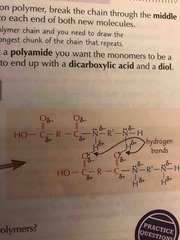![]()
![]()
![]()
Use LEFT and RIGHT arrow keys to navigate between flashcards;
Use UP and DOWN arrow keys to flip the card;
H to show hint;
A reads text to speech;
25 Cards in this Set
- Front
- Back
|
Name the different types of condensation polymers? |
• polyesters • polyamides • polypeptides |
|
|
What characterises condensation polymerisation? |
• Two different types of monomer • Each monomer has at least two functional groups • The two different monomers join together -> form a link • a small molecule is given off as a side-product |
|
|
How do you form Polyamides? |
dicarboxylic acid carboxyl groups react with amino groups of diamines |
|
|
Draw the polymer formed? |
- |
|
|
How do you form Polyesters? |
Dicarboxylic acid Carboxyl groups react with Hydroxyl groups Of Diols |
|
|
What kind of bonds are formed in polyesters? |
Ester links |
|
|
What kind of bonds are formed in polyamides? |
Amide links |
|
|
Draw an amide link. |
- |
|
|
Draw an Ester link. |
- |
|
|
Draw the polymer made from this reaction? |
- |
|
|
How can you reverse a condensation polymerisation back to the monomers? |
Hydrolysis reactions - add water molecules back in |
|
|
Which polymer is stronger and more rigid, addition or condensation? |

Condensation. • Condensation polymers are made up of chains containing polar bonds (e.g. C-N and C-O) • as well as VDWs, you get permanent dipole-dipole + hydrogen bonds - between the polymer chains |
|
|
Which have higher melting points, polyesters or polyamides? |
Polyamides. Have hydrogen bonding, not just dipole-dipole and VDWs. |
|
|
Explain why the disposal of condensation polymers is easier than addition polymers? Why is the disposal of condensation polymers still a problem despite this? |
• Addition polymers are made up of non-polar carbon chains which make them chemically inert (unreactive). This makes them non-biodegradable. • Condensation polymers have polar bonds in the chain which are attacked by nucleophiles so can be broken down by hydrolysis - they’re biodegradable • the process of breaking down condensation polymers this way is very slow |
|
|
Explain why the disposal of condensation polymers is easier than addition polymers? Why is the disposal of condensation polymers still a problem despite this? |
• Addition polymers are made up of non-polar carbon chains which make them chemically inert (unreactive). This makes them non-biodegradable. • Condensation polymers have polar bonds in the chain which are attacked by nucleophiles so can be broken down by hydrolysis - they’re biodegradable • the process of breaking down condensation polymers this way is very slow |
|
|
Name the three ways of disposing of polymers? |
•Landfill •Burned (incineration) •Recycling |
|
|
Landfill is generally used when the plastic is? |
• Difficult to separate from other waste • Not in sufficient quantities to make separation financially worthwhile • Too difficult technically to recycle |
|
|
Why is landfill a bad way to dispose of waste plastics? |
• Requires large areas of land • As the waste decomposes it can release methane (a greenhouse gas) • leaks can contaminate water supplies • many landfill sites are now reaching capacity |
|
|
What are the pros of using landfill to dispose of waste plastics? |
Cheap and easy |
|
|
What happens when incineration is used as a method of waste plastic disposal? |
Waste plastics are burnt and that heat used to generate electricity |
|
|
What is the serious downside of incineration? What is done to reduce the effects of this? |
• The burning can release toxic gases (e.g. polymers containing chlorine can release HCl) What is done: • Waste gases are passed through scrubbers which can neutralise gases such as HCl by allowing them to react with a base (The waste gases (e.g. CO2) still contribute to the greenhouse effect) |
|
|
What is the serious downside of incineration? What is done to reduce the effects of this? |
• The burning can release toxic gases (e.g. polymers containing chlorine can release HCl) What is done: • Waste gases are passed through scrubbers which can neutralise gases such as HCl by allowing them to react with a base - removing the gases from exhaust fumes (The waste gases (e.g. CO2) still contribute to the greenhouse effect) |
|
|
How are plastics recycled? |
1) sorted into different types 2) Then, there are a few options: • Some plastics - melted and remoulded • Some plastics - Cracked into monomers - used to make more plastics and chemicals |
|
|
What are the advantages of recycling plastics? |
• Reduces the amount of waste going into landfill • Saves raw materials - (oil is non-renewable) • Making plastics from scratch is more expensive than recycling them • It produces less CO2 than incineration |
|
|
What are the disadvantages of recycling? |
• technically difficult - high tech machinery • Collecting, sorting and processing the plastic is more expensive than burning/landfill • Often can’t remake the plastic you started with – you have to make something else • The plastic can be easily contaminated during the recycling process |

